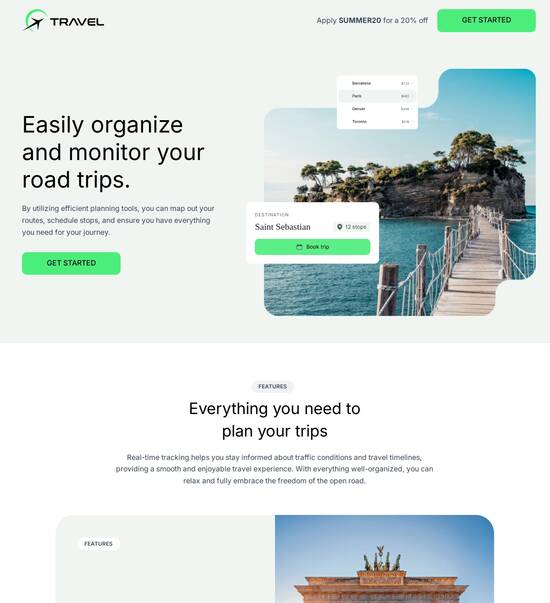
Natural & organic HTML page templates
Use TemplateAbout template
Master the art of web design with natural & organic HTML page templates. Transform your business today!
Recommended templates

Easy to build without coding
With the intuitive drag-and-drop builder, anyone on your team can create high-converting pages without any knowledge of code or design. Make enhancements to your landing page with custom widgets using Javascript, HTML/CSS, or third-party scripts.

Multiple layouts for any industry and goal
Select from 500+ landing page layouts built to boost conversions across industry-specific scenarios. Customize them by adjusting fonts, adding images, and generating on-brand content with the AI assistant. Quickly scale with Instablocks® and Global Blocks that you can save, reuse, and update globally.

Loads fast and looks polished on any device
Every template is responsive, which means they present professionally on any device and load blazingly fast with our Thor Render Engine. You can also power them up with Google AMP technology to deliver an unparalleled mobile experience and drive higher conversions.

Robust analytics & experimentation
Get real-time updates and reporting across all your devices, showing the number of visitors, conversions, cost-per-visitor, and cost-per-lead. Launch AI-powered experiments, run A/B tests, and use heatmaps to analyze user behavior, then optimize your landing page to maximize conversions.







Easy to build without coding
With the intuitive drag-and-drop builder, anyone on your team can create high-converting pages without any knowledge of code or design. Make enhancements to your landing page with custom widgets using Javascript, HTML/CSS, or third-party scripts.
Multiple layouts for any industry and goal
Select from 500+ landing page layouts built to boost conversions across industry-specific scenarios. Customize them by adjusting fonts, adding images, and generating on-brand content with the AI assistant. Quickly scale with Instablocks® and Global Blocks that you can save, reuse, and update globally.
Loads fast and looks polished on any device
Every template is responsive, which means they present professionally on any device and load blazingly fast with our Thor Render Engine.
Robust analytics & experimentation
Get real-time updates and reporting across all your devices, showing the number of visitors, conversions, cost-per-visitor, and cost-per-lead. Launch AI-powered experiments, run A/B tests, and use heatmaps to analyze user behavior, then optimize your landing page to maximize conversions.
All the features you need to build lead-generating landing pages
Explore more featuresLearn how to build top-performing landing pages for any goal
FAQs
Leading the way in building high-performing landing pages





Maximize Your ROI with Instapage’s Powerful Landing Page and CRO Solutions
Instapage stands out as a premier landing page and conversion rate optimization (CRO) platform for businesses looking to excel in digital marketing. This guide will teach you how to leverage its features effectively to enhance your marketing efforts and achieve your campaign goals seamlessly.
Why Choose Instapage for Your Landing Pages?
Selecting the right platform for building landing pages is crucial to the success of your campaigns. Instapage provides a user-friendly interface and a plethora of features that cater to digital marketers across various industries. Here are some compelling reasons to select Instapage:
- Over 100 high-converting templates: With templates designed for multiple industries, achieving optimal design and performance is effortless.
- Real-time collaboration tools: The platform allows your team to work together efficiently, enabling quick feedback and iteration.
- Advanced analytics: Track the performance of your landing pages in real-time, allowing data-driven decisions.
Step 1: Create Effective Landing Pages
Building a landing page on Instapage does not require any coding knowledge. Follow these steps to create your first page:
- Choose a template: Select from over 100 pre-designed templates tailored to your needs.
- Customize your page: Use Drag-and-drop features to add elements such as videos, forms, and images.
- Set up your analytics: Integrate tools like Google Analytics or use Instapage’s built-in tracking to monitor performance.
Step 2: Optimize with Personalization Features
Personalization increases user engagement, leading to higher conversion rates. Here’s how you can utilize Instapage’s personalized content tools:
- Dynamic text replacement: Customize headlines based on the visitor's source, making your landing page more relevant.
- AdMaps: Align specific advertisements with tailored landing pages to ensure a consistent message.
- Audience-specific metrics tracking: Analyze user behavior and conversions by audience segments for targeted improvements.
Step 3: Utilize Optimization and Testing Tools
To ensure your landing pages perform optimally, conduct experiments and make data-driven adjustments. Utilize the following:
- A/B Testing: Create variations of your landing pages to test different designs and messages, helping you identify what works best.
- Heatmaps: Use heatmaps to analyze where users click and how they navigate through your page, enabling you to improve the user experience.
- Iterate based on performance analytics: Use detailed insights to continuously enhance your page and boost conversion rates.
By leveraging these features, you can streamline your marketing efforts, allowing you to focus on what matters most — converting visitors into loyal customers.
Ready to transform your digital marketing campaigns? Sign up for Instapage today and start building high-converting landing pages that drive results!
People also ask about Natural & organic HTML page template
Understanding natural organic HTML page template: A comprehensive exploration
Defining the natural organic HTML page template
A natural organic HTML page template refers to a pre-structured format designed to create web pages that prioritize a clean, user-friendly design while adhering to best practices in development. This template is considered 'organic' because it integrates seamlessly with various content types, providing an intuitive experience for both users and developers. It is crucial to understand that these templates are not just about aesthetics; they also focus on functionality and responsiveness, adapting to different devices and user needs.
The evolution of HTML templates reflects the growth of web design as a discipline. Initially, web pages were simple static documents, but as technology advanced, so did the complexity of web design. HTML templates now incorporate advanced features such as responsive design, performance optimization, and SEO advantages, which all contribute to a more engaging user experience.
Key features of natural organic HTML page templates
Natural organic HTML page templates possess several critical features that contribute to their effectiveness and usability. One primary characteristic is modular structure, which divides the template into easily manageable sections. This modularity enhances the design process, allowing developers to reuse elements, resulting in quicker project timelines and more organized code.
Benefits of modularity include easier updates and maintenance.
Example layouts can be tailored for portfolios, blogs, and e-commerce sites.
Another feature is responsive design, which ensures that sites function efficiently on smartphones, tablets, and desktops. The techniques employed, such as media queries and flexible grids, automatically adjust the page layout to maintain usability across different screen sizes. Moreover, SEO optimization is crucial for visibility online; organic HTML templates incorporate structured data, specific meta tags, and headers to improve rankings on search engines.
To make a digital presence accessible, these templates adhere to WCAG guidelines, ensuring that all users, including those with disabilities, can navigate efficiently. Testing tools can help identify areas needing improvement, making compliance with accessibility standards a priority.
Functionality in natural organic HTML page templates
Functionality is a significant aspect of natural organic HTML page templates. They offer integration capabilities that allow seamless connections with Application Programming Interfaces (APIs) and third-party services, enhancing their versatility. For example, marketers can link analytics platforms to track user behavior, gaining valuable insights into website performance.
Modular components like sliders and galleries can be customized to align with brand identities.
CSS and JavaScript can be employed to add unique styles and interactivity.
The ability to leverage dynamic content loading is another notable feature. Templates can utilize server-side rendering for fetching data or client-side solutions like AJAX to update sections of a page without reloading, significantly improving user experience by providing instantaneous feedback.
Leveraging document functions for user interaction
User interaction is enhanced through JavaScript functions like `document.addeventlistener`, which registers event listeners for various actions, such as clicks and form submissions. This feature allows developers to create highly interactive interfaces that respond in real time to user input.
Examples of event types include 'click', 'focus', and 'submit'.
Setting up an event listener involves specifying the event type and the associated function.
A specific case study might involve enhancing user engagement through an interactive quiz or feedback form. By assigning event listeners, developers can gather data effectively, nurturing user relationships and feedback.
The importance of document ready state
Understanding the DOMContentLoaded event is vital for optimizing website performance. This event fires when the initial HTML document has been completely loaded and parsed, providing an opportunity to execute JavaScript without delay. Unlike the traditional load event, DOMContentLoaded focuses solely on the scalability and execution of critical scripts.
Optimizing event handlers to run as soon as the DOM is ready can significantly enhance user experience.
Performance can be tested using browser developer tools to measure loading times.
The timing of event execution directly affects the page’s loading performance. Ensuring that event handlers are set up efficiently can lead to swifter, more responsive designs that keep users engaged.
Enhanced user journey through organic design
Natural organic HTML page templates focus on visual aesthetics and user experience in creating meaningful online interactions. The principles of organic design emphasize simplicity, intuitive organization, and rich visual narratives. Successful implementations often highlight how aesthetic elements can increase user retention and overall engagement.
Case studies often illustrate brands that saw significant improvement in user interaction through compelling design.
Intuitive navigation systems facilitate user journeys, leading to lower bounce rates.
Creating a seamless navigation flow requires careful planning; employing breadcrumbs, drop-down menus, and logical categorization can make exploration effortless. By streamlining navigation, brands can guide users toward key objectives like conversions or sign-ups.
Benefits of using natural organic HTML page templates
One of the primary advantages of using natural organic HTML page templates is their potential for faster load times and better overall performance. Well-structured code enhances speed and efficiency, directly contributing to improved metrics. Marketers often turn to various tools to measure and improve page load speeds, leading to optimized user experiences.
Enhanced brand storytelling through visuals and interactivity fosters deeper audience engagement.
Cost-effectiveness is apparent when comparing development resources for small versus large businesses.
Moreover, organic templates are designed with scalability in mind. As businesses grow, their digital presence can adapt without requiring a complete redesign. This adaptability proves vital for companies aiming to maintain consistency while expanding their online footprint.
Future trends in HTML page template development
Looking ahead, the rise of artificial intelligence and automation tools is shaking up template development. AI can streamline the design process, analyze user behavior, and enhance personalization efforts. Predictive analytics could revolutionize how marketers engage with their audiences, tailoring experiences based on user interactions.
Eco-friendly practices are becoming crucial in web design, aligning with growing consumer awareness.
Green hosting solutions are gaining popularity among developers committed to sustainable design.
By prioritizing sustainability in HTML template creation, brands can appeal to eco-conscious consumers, reinforcing their commitment to environmental responsibility.
Case studies of effective use
Examining case studies reveals how diverse industries leverage natural organic HTML page templates for success. For instance, e-commerce sites benefit from clean templates that enhance navigation and optimize conversion rates through effective calls-to-action and vibrant product displays. Nonprofits use optimized landing pages to drive engagement and donations, capitalizing on their visually appealing, organized layouts to encourage user interaction.
Educational institutions employ templates that improve information access for students and parents.
Government websites use clean, structured layouts to enhance public accessibility and transparency.
These success stories underscore the versatility of using organic templates across different sectors, optimizing user journeys and paving the way for higher engagement levels.
Tools and platforms for creating natural organic HTML pages
Numerous tools and platforms simplify the creation of natural organic HTML pages for developers and marketers alike. Popular solutions provide features like drag-and-drop functionality, extensive libraries of pre-designed templates, and collaboration tools to facilitate teamwork on projects. Examples include Instapage and other site-building platforms that allow easy customization without deep coding knowledge.
Static templates offer simplicity but are often less flexible for ongoing updates.
Dynamic templates provide greater functionality but may require more intensive management.
Additionally, community resources and forums allow users to learn from each other, troubleshoot issues, and improve their use of various tools and platforms, fostering a sense of collaboration.
Ready to skyrocket conversions?
Supercharge your ad campaigns with high-performing landing pages
Get started














